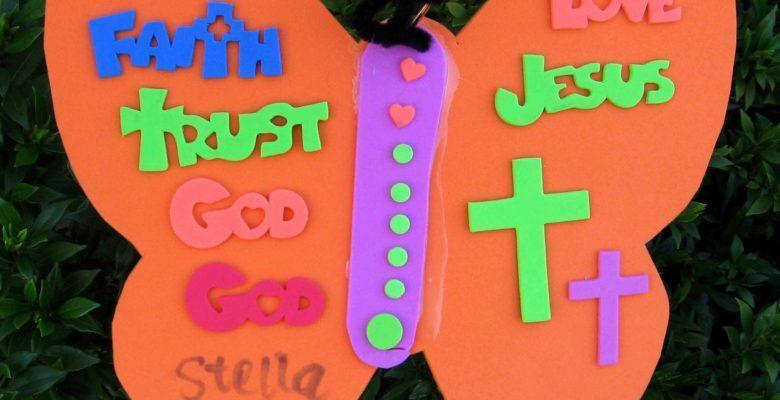“The children St. James hunt for their butterflies much like others hunt for eggs. Youth and families can be found looking for the older butterflies they made when they were younger. It is a beautiful time.”
Easter Activity for All Ages
Our Alleluia butterflies are weatherproof creations that parishioners of all ages make and place all around the grounds of St. James to herald the resurrection of Jesus on Easter morning. Each year well before the end of Epiphany, the parishioners at St. James Episcopal Church in Marietta, GA, begin asking, “Are the children going to make their Alleluia butterflies this year?” I always answer, “Absolutely!”
Early in Epiphany, I gather colorful art foam sheets, templates of butterfly shapes—both large and small—religious and springtime art foam stickers, jewels, craft glue, circle hole punches, black chenille stems, and welding rods. In addition, I locate our symbols of Christ, which are from the Episcopal Children’s Curriculum. [Symbols of Christ cards from ECC are available through the link above; look for the symbol cards in the Intermediate section: Link 1 ; Link 2 ; Link 3 ]
During Church School on the last Sunday of Epiphany, everyone gathers for the much-anticipated making of Alleluia butterflies. We begin by talking about the meaning of Lent before discussing the symbols of Easter and of Christ. Illustrations from the ECC cards showing these symbols are displayed around the room. Then it is time to begin tracing, cutting, and decorating the butterflies.
Decorating Tips
Older elementary children draw symbols with black pen or permanent marker, then adorn them with foam stickers for additional color. A thorax (the midsection of a butterfly) is cut from a coordinating color and glued between the wings for extra strength. Holes are punched at the top, and chenille stems are threaded through and curled to mimic antennae.
The preschool teachers usually precut two butterflies for each child, one stays at St. James and one is taken home, wrapped in a tissue “cocoon.” (At home the cocoons are hidden under beds or in closets until Easter morning.) Teens and adults are certainly not left out. A crafting station with all the supplies, plus directions, awaits anyone who wants to create a butterfly in the Parish Hall.
Butterfly Burial and Resurrection
After allowing time for the butterflies to dry, we process with them through the church, accompanied by the sounds of a recorded Gregorian Chant. The procession ends at the Parish Hall where they are “buried.”
As the end of Lent approaches, the butterflies are brought out for volunteers to cut two horizontal slits in each to accommodate the welding rods. (After trying wooden dowels, we found welding rods to be a strong, yet flexible mounting—one that would allow the butterflies to sway in the wind, suggesting flight.) We use 2.4mm rods that are bent back in a 45 degree angle, about 8 inches from one end. The angled end of the rod is threaded through the slits in the butterfly and secured at the back with wide, clear tape.
After the rods are added, the butterflies are returned to their hiding place. Late in the afternoon on Easter Eve, volunteers “plant” the butterflies around the church grounds. Because St. James is at the corner of two heavily traveled streets, there is much ground to cover and lots of exposure for our creations. As we set-up, we often have walkers or drivers stop and ask us questions! Through our answers, we proclaim the Good News of Easter.
Although some parishioners and visitors see the butterflies at Easter Vigil, the best time to admire the butterflies is on Easter morning. The newest butterflies are placed just outside the main church entrance, so that the children can more easily find their art. The children St. James hunt for their butterflies much like others hunt for eggs. Youth and families can be found looking for the older butterflies they made when they were younger. It is a beautiful time, as the congregation gathers to celebrate Jesus’ resurrection. I cannot imagine Easter at St. James without Alleluia butterflies.
Easter Butterflies are a tradition that is meaningful for the entire congregation. They are a creative way to bury our alleluias during Lent, and to experience the joy of Easter in a truly intergenerational way.





This article originally appeared in the Winter 2015 issue of Episcopal Teacher.
Did you enjoy this article? Consider subscribing to Building Faith and get every new post by email. It’s free and always will be. Subscribe to Building Faith.


